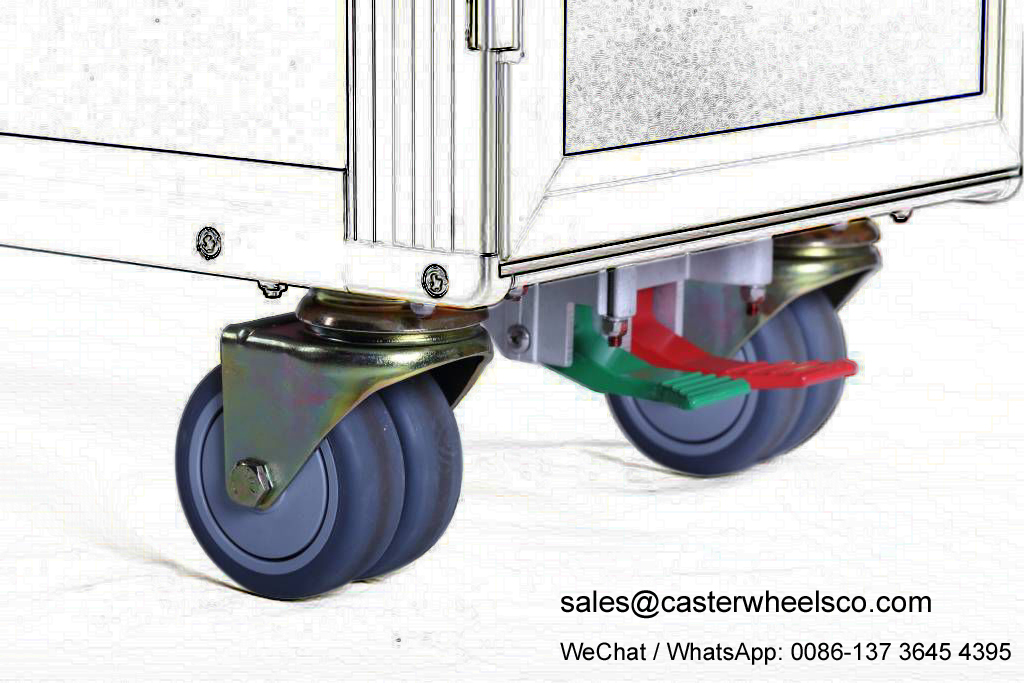The Superiority of Twin Wheel Design in Airline Trolley Casters
Airline trolleys are indispensable tools in the aviation industry, serving as mobile storage units for food, beverages, and other essential items during flights. The efficient movement of these trolleys within the confined spaces of aircraft cabins relies heavily on the design and performance of their caster wheels. While single-wheel casters have been traditionally used in various applications, the adoption of twin wheel design in airline trolley casters has emerged as a game-changer in enhancing stability, maneuverability, and load-bearing capacity. This article explores the myriad reasons why airline trolley casters benefit significantly from twin wheel design, delving into the advantages it offers in terms of load capacity, stability, weight distribution, floor protection, and overall operational efficiency.
1. Enhanced Load Capacity
One of the foremost advantages of employing twin wheel design in airplane trolley casters is the substantial increase in load capacity. Airline trolleys are tasked with transporting a diverse range of items, including meals, beverages, and amenity kits, which can collectively exert significant weight on the caster wheels. By utilizing twin wheel casters, the load-bearing capacity of the trolleys is greatly enhanced. The dual-wheel configuration distributes the weight more effectively across two wheels, thereby reducing the strain on each wheel and minimizing the risk of overloading. This increased load capacity not only allows airlines to efficiently transport larger quantities of supplies but also ensures the longevity and durability of the caster wheels under heavy loads.
2. Superior Stability
Stability is a critical factor in the design of airline trolley casters, particularly in the context of ensuring the safe and secure transportation of items onboard aircraft. Twin wheel casters offer superior stability compared to their single-wheel counterparts due to their wider footprint and dual-wheel configuration. The broader base provided by twin wheel casters enhances the overall balance and steadiness of the trolleys, reducing the likelihood of tipping or swaying during transit. This heightened stability is essential in mitigating the risks associated with sudden movements, turbulence, or uneven surfaces within the aircraft cabin, ultimately enhancing the safety and efficiency of in-flight service operations.
3. Optimal Weight Distribution
Efficient weight distribution is a key consideration in the design of airline trolley casters to prevent uneven wear and tear, minimize stress on individual components, and ensure smooth operation. Twin wheel casters excel in achieving optimal weight distribution by evenly dispersing the load between two wheels. This balanced weight distribution alleviates pressure points and reduces the risk of wheel deformation or damage, especially when traversing rough terrain or navigating obstacles. By promoting uniform weight distribution, twin wheel casters enhance the longevity and reliability of the trolleys, allowing them to withstand the rigors of daily use in demanding aviation environments.
4. Floor Protection and Durability
Preserving the integrity of aircraft cabin flooring is paramount in maintaining a clean, presentable environment for passengers and crew members. Twin wheel casters play a crucial role in safeguarding the flooring surfaces from scratches, scuffs, and indentations commonly caused by caster wheels. The use of softer wheel materials, such as rubber or polyurethane, in twin wheel casters helps mitigate potential damage to delicate flooring, ensuring that the trolleys glide smoothly without leaving marks or blemishes behind.
Furthermore, the wider footprint of twin wheel airplane trolley casters distributes the weight more evenly, reducing the risk of causing structural damage to the flooring materials. By prioritizing floor protection and durability, airlines can uphold the aesthetics and functionality of their cabin interiors while extending the lifespan of their trolley casters.
5. Enhanced Maneuverability and User Experience
Smooth maneuverability and user-friendly handling are essential qualities in airline trolley casters to optimize operational efficiency and enhance the overall experience of cabin crew members. Twin wheel casters deliver enhanced maneuverability by facilitating seamless rotation, precise steering, and effortless gliding through narrow aisles and tight spaces. The dual-wheel configuration of twin wheel casters enables trolleys to navigate corners, turns, and obstacles with ease, reducing the physical strain on cabin crew members tasked with trolley operations. By enhancing maneuverability and user experience, twin wheel casters contribute to a more streamlined and efficient inflight service delivery, enabling airlines to provide exceptional service to passengers while maintaining a comfortable working environment for their staff.
Conclusion
In conclusion, the adoption of twin wheel design in airline trolley casters represents a significant advancement in the realm of aviation equipment, offering a multitude of benefits that cater to the unique operational requirements of airlines. From increased load capacity and superior stability to optimal weight distribution, floor protection, and enhanced maneuverability, twin wheel casters elevate the performance and functionality of airline trolleys in a variety of ways. By embracing twin wheel design, airlines can optimize the efficiency, safety, and durability of their trolley fleets, ultimately enhancing the overall passenger experience and operational excellence. As the aviation industry continues to evolve, twin wheel casters stand out as a dependable and innovative solution for meeting the dynamic challenges of modern air travel and ensuring the seamless transportation of goods and services onboard aircraft.


 English
English Spanish
Spanish German
German Russian
Russian Arabic
Arabic Portuguese
Portuguese Italian
Italian French
French Hebrew
Hebrew Turkish
Turkish